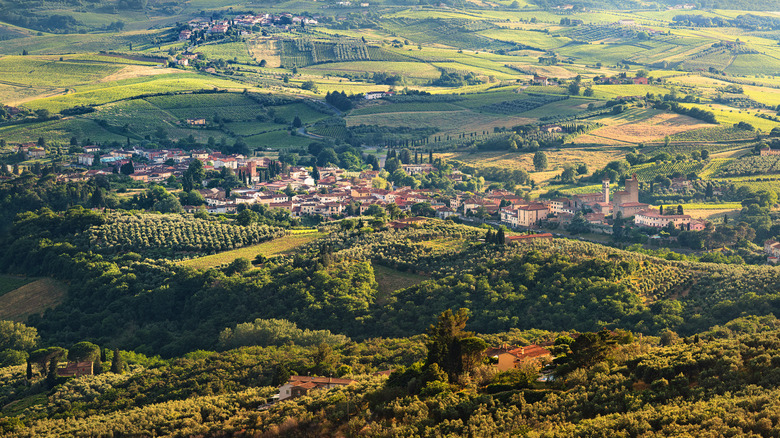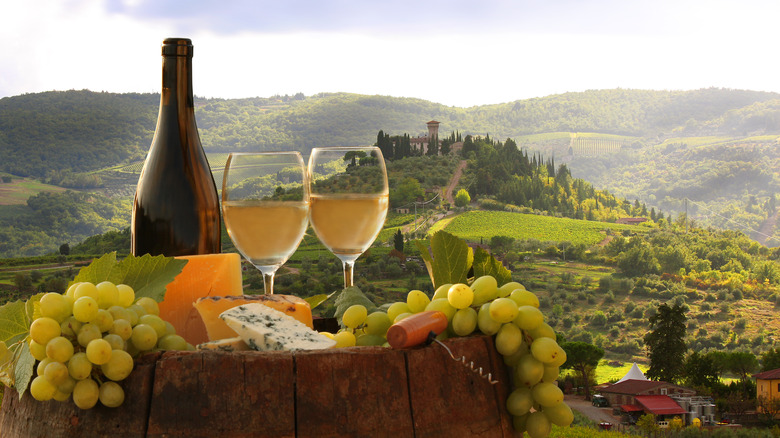Hills, Olive Groves, And Slow Tourism Define The Breathtaking Italian Birthplace Of Da Vinci
To see the "Mona Lisa," you need to take to your tiptoes to peer over the swarm of admirers in her hall in the Louvre. Standing before the "Last Supper" requires loitering in a painfully long queue snaking out of Milan's Convent of Santa Maria delle Grazie. Marveling at the "Vitruvian Man" means battling your way through the densely congested canal sides of Venice. Art lovers worldwide will contend with the thronging crowds and tourist trappings just to get a glimpse at the works of Leonardo Da Vinci. Yet, his hometown has managed to bypass the fate of the beautiful destinations in the world sadly ruined by overtourism.
Vinci, situated amid rolling Tuscan orchards and tiny, medieval cliffside towns, is a quintessential Italian destination. It overlooks the olive groves from its hilltop perch, distinguishable by its soaring castle tower and winding cobbled lanes, oriented around the small-town piazza. Unlike most Italian villages, Vinci's famous son and the interest he attracts mean that they have good tourism infrastructure and connection to the rest of the country. It's easy to access the town from the art-filled historic gem of Florence, with a trainline connecting the Tuscan capital and Emboli, and a regular bus route traveling onwards from Emboli to Vinci. It's also possible to drive, though Italian roads can be hair-raising for newcomers.
Enjoy Tuscan charm and rich art history in Vinci
Exploring the narrow stone-walled lanes and medieval pathways that navigate Vinci will always lead you to a vestige of its favorite son. It draws in fans of Renaissance art, engineering, science, design, mathematics, architecture, or any of the polymath's other areas of generational expertise. There's a museum in town, Museo Leonardiano di Vinci, dedicated to the advanced technological inventions of the artist, with models recreated precisely from his myriad journals and sketches. Still more of his creations are on display in other parts of the sprawling Conti Guidi, the fortress which has stood sentinel over the town since the Middle Ages.
From the highest point in the castle, it's easy to look out over the rolling hills and gorgeous Renaissance villages that the Tuscan countryside is famed for. Ironically, it offers a view of where the artist was actually born. He didn't arrive to the world in Vinci's town bounds, but a short distance away in a farmhouse outside Anchiano. It's worth visiting on an easy walk from town, along 1.8 miles of the vineyard-lined Sentiero Verde. Follow up with a visit to his baptismal church, the Church of Santa Croce, where a tablet recording his birth has been preserved, written by his grandfather Antonio da Vinci.
Sleep, eat, and drink in Vinci, Tuscany
Heaping plates of slow cooked meats, bowls of pasta in rich sauce, and an arguably excessive volume of cheese are a given on any Italy trip. In Tuscany, in particular, fresh flavors and high-quality produce come to the fore. In Vinci, sample classic local dishes at Da Pippo. The no thrills local favorite serves pappardelle coated in wild boar ragu, ravioli doused in saffron cream, and creamy homemade tiramisu.
Essential to any Tuscan trip is a tour of the sloping vineyards that coat the county. Travel out of the city to yet another homage to the famous painter, the Leonardo Da Vinci cellars, to sample the brews of a group of winemakers growing grapes on the slopes of Montalbano. Sip on glasses of chianti and Brunello di Montalcino while learning about Da Vinci's devotion to viticulture and agricultural technology. Most travelers visit Vinci on a day trip from Florence, but others choose to stay overnight to enjoy the bucolic calm of the Tuscan country evenings. Rest your head at the peaceful and exceptionally conveniently located Hotel Monnalisa.


